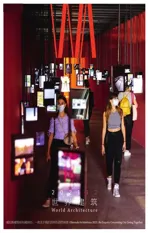从图纸到建筑:2021年威尼斯双年展中国馆建设过程中的参与者、条件和影响
2021-12-24马塔曼奇尼余紫悦张显MartaManciniYUZiyueZHANGXian余紫悦张显TranslatedbyYUZiyueZHANGXian
马塔·曼奇尼,余紫悦,张显/Marta Mancini, YU Ziyue, ZHANG Xian余紫悦,张显 译/Translated by YU Ziyue, ZHANG Xian
第17届威尼斯国际建筑双年展中国馆布展是一个空间的错综复杂的非线性变化的过程。2021年9月-11月期间,展馆的室内和室外结构静静地矗立在威尼斯旧军械库展区里。然而从建筑学角度看,展馆是一个由多方参与者、构成实体和背景条件的复杂网络交织而成的动态空间[1]。策展及设计者是总部设在北京的建筑师张利教授及其团队清华大学建筑设计研究院简盟工作室,由于疫情原因展览的搭建在主设计师被迫 “缺席”、布展推迟的情况下进行,并在现场进行了简单的修改。
本文以图片和文字的形式对2021年威尼斯双年展中国馆的施工过程进行了描述,反映了其实现过程的复杂性,不仅体现在空间元素的构成方面,而且体现在社科艺术品的构建方面[2]。作者旨在展开从构思到建成建筑的多方面的设计过程:这个过程通常试图实现 “最大限度地保存”和 “最小的损失”[3],但需要进行转译、演绎和重新设计的步骤。下面的调查也是为了引发对建筑如何形成的思考,或者换句话说,当设计师不在现场,不能直接了解到当地环境和场地特征时,设计如何变成实际的建筑。中国馆是这些条件的缩影,并且体现了设计师无法到达现场、当地建筑师和专业人员这些因素之间的关系及性质将如何影响所造建筑的呈现效果。
本文的作者部分地参与了设计过程,并在施工阶段作为现场管理团队的成员。因此,文章的叙述提供了一个来自 “内部 ”的观点。论点围绕着5个关键词的探讨,这些关键词概述了在整个布展完成过程中遇到的主要难点:延迟、缺席、演绎、整合、重新设计。文章配合现场照片以提供视觉的信息。并使用图表,通过系统的、概要的、涵盖参与者的关系图来进一步丰富阐述。参与者之间的相互影响和互动也在时间线上得到了体现[4]。
中国馆的落地过程解决了该项目在实体,内容,关系上的特征问题。“实体”表示了展览中实体的构件和技术设备;“内容”代表类似数字资料的展示;“关系”指代多方参与者和实际情况以及他们对最终建筑呈现的影响。
以“院儿:从最大到最小” 为题,中国馆在空间上通过建筑元素分为5部分展示[5]。游览路径从30m长的廊道开始,在3m高的石膏板墙之间悬挂着110台平板显示器,展示职业建筑师在作品中对院儿(中国传统多户共享的院落)的相关诠释。接着转入了6个相继排放位于标志性弧墙后方的“盒子”。弧墙长34m、高7m,表面以铝板覆盖,由16根钢柱支撑。在室外,在有顶棚的开放结构中,固定了16块彩色的刻有图案的面板,描绘着中国的街巷游戏(图1)。
原定于2020年举办的第17届威尼斯双年展的策展委托和中国馆的空间主题构思都开始于2019年夏天。初步阶段在2020年1月中旬告一段落,最终的设计方案递交给了威尼斯双年展组委会。此后,新冠肺炎疫情成为了最主要的一个“因素”[6],影响着中国馆施工现场、威尼斯双年展组织以及全球范围活动运营的原定计划。
延误
在中国馆建造初始,“延误”作为一个内在的因素出现了。疫情不仅仅导致了公共卫生相关的安全限制,还有物流延期的问题。在2020年4月中旬,威尼斯双年展宣布由于疫情影响,开展日期将从2020年5月23日延迟到8月29日。从那时起,中国馆策展方改变了在意大利当地购买材料并管理整个制造过程的最初计划。当时由于劳动力和建造材料的成本提升,以及2020年春季的严格封锁,许多意大利的工厂和建筑公司关闭,大部分预制工程转移到了中国北京。2020年5月,双年展主办方宣布第17届国际建筑展最终将推迟到2021年5月22日-11月21日。这个决定不仅仅考虑到在当时的情况下,无法举办这类大型国际性活动,也表达了对参加由哈希姆·萨基斯策展、主题为“我们将如何共同生活”展览的建筑师和参与方的尊重[7]。北京华薇天成文化传媒有限公司在2020年完成了预制过程,并在2021年初进行了预搭建测试。在接下来的时间里,所有的结构和饰面材料被储藏起来,等待被运往威尼斯。
2021年5月22日,第17届国际建筑展正式向公众开放。由于全球封锁的几个月里,海运货物积压,送达的日期一再推迟。最终,在8月13日,集装箱才抵达威尼斯军械库。
时间维度的因素变得非常关键,也让现场及时的修改变得必不可少。时间影响了建筑构件的“实体”和“关系”特征。计划的推迟和船运的拖延意味着预制件面临长时间的存储和暴露在温差较大的环境。这导致了一些构件的变形和饰面材料的劣化。此外,船运的延期也给当地施工带来挑战,他们不得不加快整个施工的进程。
缺席
The China Pavilion installation at the 17th International Architecture Exhibition - La Biennale di Venezia has been the spatial outcome of an nonlinear process. Between September and November 2021, the indoor and outdoor structures of the pavilion stood still and majestic in the Arsenale. Nonetheless, they innerly vibrated of the dynamics that had been performed by an intricate network of interacting actors, constituting entities and contextual conditions[1]. Curated and designed by architect and professor ZHANG Li, based in Beijing - Atelier TeamMinus, Tsinghua University, the physical on site completion of the installation was partly characterised by compelled "absences", postponements and in itinere modifications.
The present article proposes the textual as well as pictorial portrayal of the assembly phase of the China Pavilion at La Biennale di Venezia 2021, reflecting on the complexity of its realisation process, not only in terms of spatial elements' composition, but in terms of implications of a sociotechincal artefact's construction[2]. The authors aim to unfold the multifaceted process of design that led from conception to built architecture: a process that generally attempts to "maximum preservation" and "minimum loss"[3], yet required operations of translation, integration and redesign. The following enquiry intends also to trigger reflections on how architecture can happen, or in other words, how design can turn into built architecture when the designer is not present on site and does not have direct access to local environmental and context's features. China Pavilion epitomises these conditions and offers, in addition, insights on how the nature of the relationship between the non-present designer, on one hand, local architect and professionals, on the other, can affect the architectural outcome.
The authors of the article were partially involved in the design process and were part of the site manager team during the construction phase. Therefore, the narration provides a point of view from "within". The arguments are organised around the discussion of five keywords that outline the main entangled challenges encountered throughout the completion of the installation: delay, absence, interpretation, integration, redesign. Pictures integrate the text with visual information. A diagram enriches the narration through a systematic and synoptic mapping of the actors involved. Their implications and interactions are taken into account in terms of diachronic networks[4].
The realisation process of the China Pavilion is tackled in terms of physical, content and relational features of the project. "Physical" stands for the spatial elements and technological devices of the exibition; "content" for the analogical and digital materials displayed; "relational" for the actors involved as well as for the contextual conditions and their effects on the final built outcome.
Titled "Yuan-er, a Courtyard-ology: From the Mega to the Micro", the Chinese pavilion included five conceptual sections spatiallly displayed through different architectural elements and digital devices[5]. The path visit started with a 30-metre-long corridor defined by 3-metre-high plasterboard walls where 110 pads hanged and showed videos of practicing architects' interventions related to yuan-er - the Chinese multi-family traditional courtyard. It then turned along six subsequent "boxes", positioned on the back of a monumental curved wall: a 34-metre -long and 7-metre-high surface of alluminium panels, supported by 16 steel pillars. Outdoor, a covered open structure framed 16 carved coloured panels depicting Chinese street games (Fig. 1).
The process of both curatorship and spatial conception of the China Pavilion for La Biennale di Venezia 2021 (originally 2020) begun in Summer 2019. This early phase ended around mid January 2020 when a final design project was delivered to the organising committee of La Biennale. Thereafter, COVID-19 pandemic became a major "actant"[6], impacting on the original schedule of China Pavilion's construction site, La Biennale di Venezia organisation and worldwide operations.
Delay
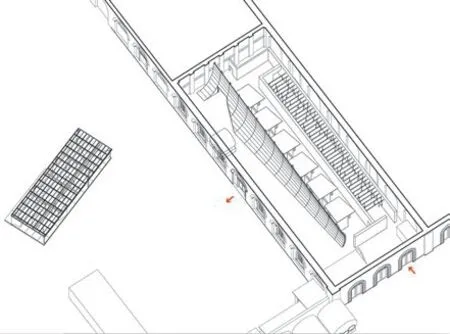
1 中国馆轴测:2021年威尼斯双年展,都灵理工大学管理团队现场修改后的展览设计/Axonometry of the China Pavilion - La Biennale di Venezia 2021, exhibition design after on site modifications made by the site manager team from Politecnico di Torino ©Atelier TeamMinus & China Room - Politecnico di Torino
Delay emerged as an inherent condition of the China Pavilion realisation process; firstly, due to health-related restriction measures, secondly, to logistic issues, both caused by the break out of the pandemic.
In mid April 2020, La Biennale annoucend the postponement of the opening date from May 23 to August 29, 2020, as a first response to the health emergency. At that point, China Pavilion curator's earliest plan of purchasing and managing the entire production process in Italy changed. Due to the cost of labour and building materials and to the strict lockdown in Spring 2020 - that forced the closure of factories and construction companies in Italy - most of the prefabrication process was moved to Beijing, China. In May 2020, La Biennale announced the definitive postponement of the 17th edition of the International Architecture Exhibition to May 22 - November 21, 2021. The decision was taken in view of the impossibility of managing such articulated and international event, and also as a sign of respect towards the commitment of architects and participants to the "How will we live together?" exhibition curated by Hashim Sarkis[7]. The Beijing Huawei Tiancheng Culture Media Co., Ltd construction company completed the prefabrication process in 2020 and tested the elements' assembly in the early months of 2021. During the rest of the months, structural and finishing materials were stored waiting to be shipped over to Venice.
On May 22, 2021, the 17th edition of La Biennale opened to the public. The shipment did not follow the planned schedule. Due to maritime traffic accumulated throughout months of global lockdown, the delivery was further delayed. The containers eventually arrived at the Arsenale in Venice on August 13.
The dimension of time played a crucial role and brought to necessary on site in itinere modifications. It impacted on both the "physical" and the "relational" features of the installation. The schedule postponement and the prolonged period of transition by ship implied the storage of the prefabricated structures and their exposure to large temperatures excursions. In some cases, this caused the alteration of structural elements' shape and the deterioration of finishing materials. Moreover, the delay of the containers' delivery raised challenges in managing the labour force on site which had to speed up the construction process.
Absence
Not only the temporal but also the spatial dimension impacted on the completion of China Pavilion's installation. The entire Chinese curatorial team was not able to reach Venice due to the pandemic break out and the travel restrictions. The physical distance between Beijing and Venice caused the absence of the curator designer on the working site and a number of related consequences. In order to deal with this compelled condition, curator ZHANG Li commissioned the supervision of the pavilion's construction to an international group of researchers and students of the China Room research centre and the Department of Architecture and Design-DAD at Politecnico di Torino, Italy, coordinated by professor and architect Michele Bonino. Thanks to the collaborative relationship with Tsinghua University established almost a decade ago, the Politecnico team was entrusted as site manager and interpreter of the curatorial project. The main goal was to pursue a high-quality architectural outcome that respected the original design and at the same time responded to on site features and requirements.
The absence of the curator on site implied actions that would have not been performed otherwise. First, videos showing the assembly process of the architectural elements were shooted during structural tests in China by the manufacture company to instruct the construction companies in Venice. Second, since in some cases design drawings did not provide detailed information about the prefabricated structure, the site manager had to interpret them. Third, on site modifications and integrations required negotations with the curator designer. Fourth, alterations of the original project were needed to respond to safety requirements, incorrect survey measurements of the site and materials' deterioration.
The set up of the construction process was challenging. The building procedure had to be adapted to on site features. For instance, the existing building of the Arsenale hosting China Pavilion is much smaller than the producing factory in China. This condition impacted on the assembly process of the curved alluminiun wall. Nonetheless, once the cooperative and interactive relation among the curatorial team and the construction company in China, the Politecnico team, the contractor, the test engineer and the construction companies in Venice was clarified and strengthened, the progress of the construction was only challenged by the deterioration of the building materials. At every step, the Politecnico team checked the procedures on site with the construction companies and the engineer in charge of the final test, and reported to the curatorial and Chinese construction team, constantly discussing and negotiating modifications and integrations when necessary. In this way, the circumstance of contingent "absence" was rapidly turned into a regular "dialogic interaction" among the actors involved, led and filtered by the curatorial team, on one hand, and the Politecnico team, on the other.
不仅仅是时间维度上的因素,空间维度上的因素也影响着中国馆的搭建。由于疫情,整个中国的策展团队无法到达威尼斯。北京和威尼斯之间的客观距离造成了策展人设计师在工作现场的缺席以及一系列相关后果。为了应对这种迫不得已的情况,策展人张利委托中国室研究中心及意大利都灵理工大学建筑与设计系(DAD)的研究人员和学生组成的国际小组监督展馆的建设,由建筑师、教授米凯利·博尼诺协调现场工作。由于与清华大学建立了近10年的合作关系,都灵理工团队被委托作为现场管理者,成为策展项目的现场阐释者。我们的主要目标是追求高质量的建筑成果,在尊重原设计的同时,也需要灵活变通以满足现场的特点和要求。
策展人不在现场,就意味着不得不增加一些行动。首先,在中国的结构测试期间,制造公司拍摄了建筑构件搭建过程的视频,以指导威尼斯的施工公司。其次,由于部分设计图纸没有提供关于预制构件的详细信息,因此现场管理人员必须对其进行解释。 第三,现场的修改和整合需要与策展设计师进行协商。第四,需要对原项目进行修改,以适合安全要求、解决对场地尺寸误差和材料的劣化产生的问题。
施工过程的推进是具有挑战性的,建筑程序必须适应现场的特点。例如,中国馆所在的军械库旧建筑比中国预搭建团队的工厂小许多。这种情况影响了弧形铝板墙的搭建过程。尽管如此,一旦策展团队和中国的建筑公司、都灵理工团队、承包商、测试工程师和威尼斯的建筑公司之间的合作和互动关系得到明晰和加强,施工的进展则只受到建筑材料劣化带来的挑战。在每一个步骤中,都灵理工团队都与建筑公司以及负责最终测试的工程师一起监督现场的施工过程,并向中国展馆负责人和中国建筑团队报告,在必要时不断讨论和协商修改和整合。以这样的方式,在策展团队和理工大学团队的引导和过滤下,特定环境下的 “缺席”迅速演变成为相关合作方之间的定期 “对话式互动”。
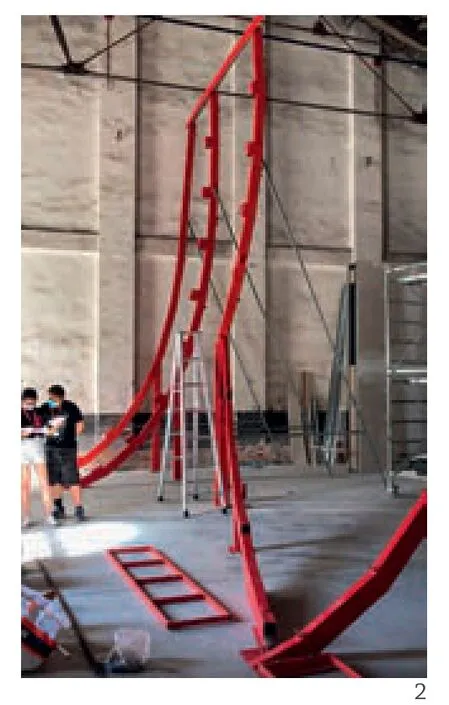
2 曲线墙的早期施工阶段。在安装前3根立柱时,由于材料在储存和运输过程中变形,导致立柱顶部错位,现场施工团队受到误导/Early construction phase of the curved wall. When setting up the first 3 columns, the construction team on site was misled by the misalignment of the top of the pillars caused by material's deformation during storing and shipping ©Marta Mancini
演绎
来自都灵理工大学的监理团队弥补了策展团队在施工和搭建过程不在场的情况,不仅保证了搭建的完成,更追求将原本设计方案完整地转译成真实的建筑。在中国馆的案例中,建筑师的设计媒介:图纸——和他的作品的最终成果建筑——之间的区分明显地显现出来[3]。这个转译的过程意味着对原本设计的演绎。转译过程包含了两个层级,首先是一般建造过程中也常常遇到的、从图纸到建筑物的转译。其次是从策展方设计师的视角到更了解现场情况的当地建筑师的视角的转译。由可信赖的专业设计师团队担任施工现场的监理,对于策展方案全面而准确的演绎至关重要。
比如,预制铝板墙的建造就具有挑战性。三维建模曲面的剖面并没有从上而下统一,二维图纸所提供的装配步骤信息非常有限(图2-5)。此外,由于从中国发送的部件的标签不系统,现场施工团队需要监理建筑师的支持,以确定结构的层次结构,以便与构件匹配(例如立柱对齐、龙骨分布、临时对角支撑定位、弧形墙与背面支撑“盒子”之间的连接,图6)。
整合
监理团队不仅协助威尼斯建造团队更好地根据设计图纸和中国预制公司拍摄的指导视频对设计进行演绎,他们更保证了搭建过程的效率,控制了搭建部分的品质,同时采取积极主动的方法弥补现场的错误。在一些搭建部分,施工管理者需要临时地担任设计师的角色,提出技术上整合的方案和根据策展方的设计理念的局部重新设计。
比如,在展览的第一部分,悬挂平板显示器的金属管的长度和原本设计不一致。因此,都灵理工团队重新排布了平板的位置和它们各自对应的金属管,旨在达到最初设计的在展廊上形成三维拱廊的视觉效果。此外,不仅仅是实体构件的重新整合,平板廊展示的内容也需要重新整合。最初的设计是由110部平板展示建筑师的访谈,并在特定时间同步出现孔明灯的景象。虽然,策展团队提供了媒体管理平台,可以根据平板的注册编号控制在线的平板,然而,由于运输的问题,所有的设备失去了远程连接,并且无法和原本设定的位置相对应。作为补救措施,监理团队不得不依次登记每个设备的Mac地址并重新投放正确的视频。这些对电子设备的重新设置、整合,对于最终效果的完整连贯呈现是必不可少的(图7)。
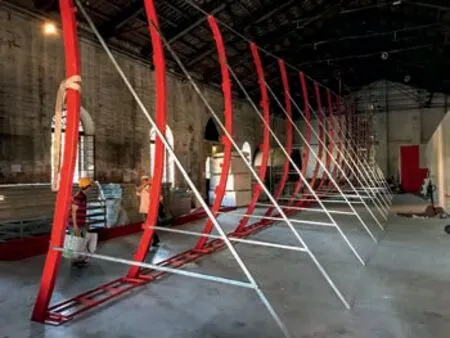
3 曲线墙结构:支柱和临时支撑结构/Curved wall construction. Pillars and temporary supporting structures ©Marta Mancini
重新设计
出于两个原因一些重新设计是有必要的。首先,在现场的测量和当时考察后绘制的图纸数据不同:现实中的空间更狭窄。这些数据的误差意味着一系列现场的改动:整个弧形墙在平面上转动了,同时6个盒子的体量被重新设计,为了让走廊达到最低的安全通行宽度,一块结构板被移走。其次,一些建筑材料在船运储存期间严重地劣化了。室外展馆的两层屋面材料损坏且无法使用。由于只有在第一块面板安装到位后才能进行评估,在当地工程师确认预制结构不适合抵抗威尼斯定期发生的强风天气后,不得不修改和重新设计。现场管理团队向策展人提出了不同的解决方法,建议用半透明的轻质织物代替原本不透明的屋面覆盖材料,并且改变了最终建筑呈现的空间感受(图8)。
尽管困难重重,在2021年9月15日,室内和室外展馆终于向公众开放了,而距离最初的设想已经过去了将近两年。
对这5个关键词的分析让中国馆的一些隐藏特征浮出水面,更广泛地说,是建筑的一些隐藏特征。如图表所示(图9),纵观实体和内容特征,关系特征——由参与者和特定情境组成——使得最终的建筑以这样的形式呈现。
疫情在时间和空间维度上都影响了威尼斯双年展的呈现。推迟和延误对搭建造成了时间上的转移。相应地,这也导致了承包商对威尼斯施工团队的重新选择,施工时间的压缩,建筑材料的劣化此类问题。否则室外的屋面材料就不会重新设计。
假如策展团队可以到达现场?他们会不会找到不同的方案来整合设计呢?在第17届威尼斯双年展中,中国馆不是唯一一个面临策展团队“缺席”的展馆。比如,日本馆也是其中一个遇到类似情况的展馆。然而,在日本馆,策展方“接受”缺席施工现场以及部分装置构件在船运期间丢失的情况,并且接纳它们作为展览理念的一部分[8]。在中国馆,目标则是即便遇到突发情况,也要尽可能地尊重初始设计。而选择可信赖的现场监理团队则是实现最终建造的关键。
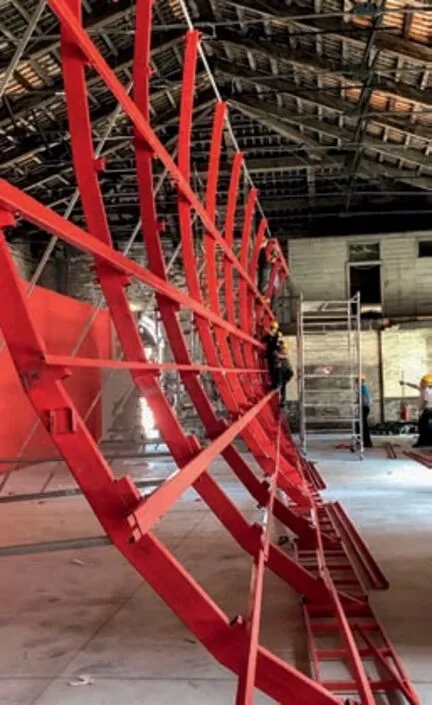
4 曲线墙结构:支柱和龙骨/Curved wall construction. Pillars and keels ©Marta Mancini
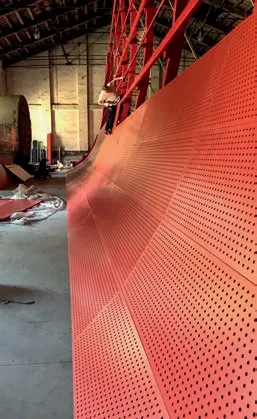
5 曲线墙结构:铝板的定位/Curved wall construction. Positioning of aluminium panels©Marta Mancini
在一般的建造过程中,如果设计者能在施工现场,项目的材料文件归档就不需要了。建筑师可以将所有施工操作一步步地描绘出来,如需要采取怎样的尺寸、需要建造怎样的体量,他可以指导工人如何对构件进行塑形和展示。但建筑师经常会因为各种各样的原因而无法抵达现场,进而将他们这种任务的实现委托以工程文件[9]。相应的,这些工程文件需要被转译和演绎。正如前OMA设计师奥雷·舍人所说:“解释和翻译的过程是一个过程,设计只有在建筑完工时才会停止。有时甚至不存在,因为建筑一直在变化。”[10]
图纸是建筑师的主要手段之一,是探索和实验的工具。它们在建造之前就要完成,“它们存在于构造体验发生之前。”[11]它们因现实中无法预见的、图纸之外的现实中各种不可抗力因素而被充分利用[12]。它们揭开了将建的建筑的面纱,同时允许插入不同的想法作为替换。然而,“绘画和建筑之间的变化在很大程度上仍然是一个谜”[13]。
尽管中国馆的建造过程中有被迫延期和(建筑师)缺席的情况,但最终建成的展览仍体现出策展团队、现场管理团队和建造公司之间沟通与合作的能力。在富有成效的协商中,讨论得出的修改和整合方案带来了计划外的高质量结果。由于多年的合作,监理团队对于策展人的想法和工作方式十分熟悉[14], 在某些情况下,监理团队仅仅负责现场对原本设计图纸的演绎,在少数特定情况,监理团队也担任了积极主动的设计师的角色。

6 曲线墙:共同感受/Curved wall - Together we Feel ©Samuele Pellecchia/Prospekt
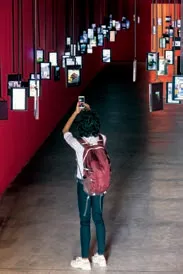
7 “平板街”:共同学习(第一部分)/Pads street -Together we Learn (Part I) ©Samuele Pellecchia/Prospekt
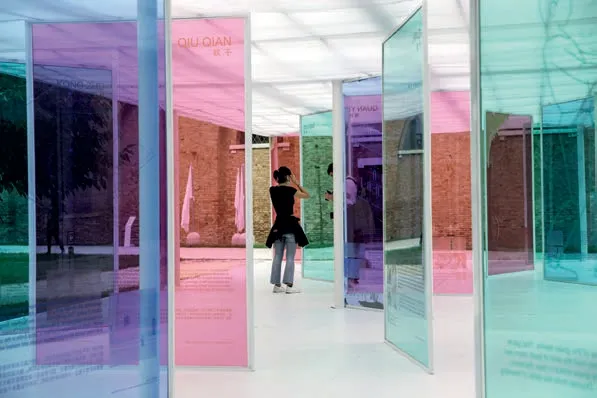
8 户外展亭:共同治愈/Outdoor pavilion - Together we Heal ©Samuele Pellecchia/Prospekt
疫情一直在影响着我们对建筑的构思和建造方式。设计者对现场的缺席通常会导致施工效率和美学品质的显著降低,甚至发生事故[15]。尽管如此,中国馆证明了(在这种情况下)建筑仍然可以落成,以及相互信任和信息交流的纽带可以将建筑师的缺席转变为一个建造的多方交流过程,最后落成计划外但仍具有高质量的建筑。□
Interpretation
The supervising site manager team from Politecnico di Torino compensated the absence of the curator architect during the construction and assembly works, guaranteeing the completion of the installation and pursuing the translation of the original design drawings into built architecture. In the case of the China Pavilion, the separation between the architect's medium of design -drawing - and the final the outcome of his work - the building - emerged distinctly[3]. The act of translation implied operations of interpretations of the original design. The translation was operated at two levels. First, from drawings to built up space, as it ordinarily happens in the architectural discipline. Second, from curator designer's vision to local architect's direct understanding of on site conditions. The on site supervision by a trustful team of professional designers was essential for the accurate interpretation of the comprehensive curatorial project.
The construction of the prefabricated alluminium curved wall, for instance, was challenging. The three-dimensionally modelled surface did not have a uniform section and the twodimensional drawings provided limited information about the assembly procedure (Fig. 2-5). Moreover, due to the unsystematic labeling of the components sent from China, the construction team on site needed support from the supervising architect to figure out the hierarchy of the structure, and match the physical elements (e.g. columns alignement, keels distribution, temporary diagonal supports positioning, linkage between the curved wall and the supporting "boxes" in the back, Fig. 6)
Integration
The supervising team not only supported the construction company in Venice in the interpretation of the design drawings and the instructive videos shooted by the manufacturing company in China. It guaranteed also the efficiency of the construction process, it controlled the aesthetic quality of the architectural outcome and it adopted a proactive approach to on site errors remediation. In some operations, the site manager temporarily took up the role of the designer proposing technical integrations and details redesign, in coherence to the curatorial and design concept.
In the first section of the exhibition, for instance, the length of the pipes supporting the hanging pads turned out not to correspond to the original design. Therefore, the Politecnico team reorganised the position of the pads and their corresponding pipes to form the original visual "arch" developed three-dimensionally throughout the corridor. Furthermore, not only the physical but also the content features of the pad street needed on site integrations. The original plan was to have 110 pads displaying interviews of architects and one shared image of a lantern showing up synchronously. Although, the curatorial team had provided a media management system to control online the single pads based on their registration number, due to transportation problems, the devices lost their remote connection and were unable to match with the originally designated position. As remediation, the supervising team had to record again the Media Access Control Address of all devices and relink the correct video one by one. These operations of reset of the digital devices were necessary integrations to guarantee the coherent final performance of the installation (Fig. 7) .
Redesign
A few actions of redesign were necessary for two reasons. First, on site measurements turned out to be different from those reported in the aftersurvey drawings: the real space was narrower. This erroneous information implied a series of in itinere modifications: the rotation in plan of the entire curved wall and the redesign of the six boxes' volume through the removal of one structural panel in order to meet the minimum safety requirements of corridors' width. Second, some building material were highly deteriorated due to the prolonged storing periods. Two layers of the outdoor pavilion's roof were damaged and inoperable. Since this evaluation was possible only after the first panels were put in place, when the local engineer verified that the prefabricated structure would have not been suitable to resist conditions of strong wind periodically occuring in Venice, modifications and redesign were necessary. The site manager team proposed to the curator a different formal solution, suggesting to substitute the opaque layer cover with a semi-transparent light fabric and, thus, changing the spatial atmosphere of the final architectural outcome (Fig. 8).
Despite the numerous challenges, on the 15th of September 2021 the indoor and outdoor pavilions eventually opened to the public after almost two years from their preliminary conception.
The analysis of these five keywords has let emerge some hidden features of the China Pavilion and, more in general, of architecture. As shown in the diagram (Fig. 9), looking over the physical and the content features, the relational ones - consisting of actors and contextual conditions - were what made the final built outcome possible in the way it showed.
The pandemic impacted on the display of Venice Biennale in terms of both temporal and spatial dimensions. Postponements and delay caused a temporal shift in the realisation of the installation. In turn, this implied the reselection of the construction companies by the main contractor in Venice, the reduction of time of the on site processes and the deterioration of building materials. Would the cover roof of the outdoor structure have not been redesigned otherwise?
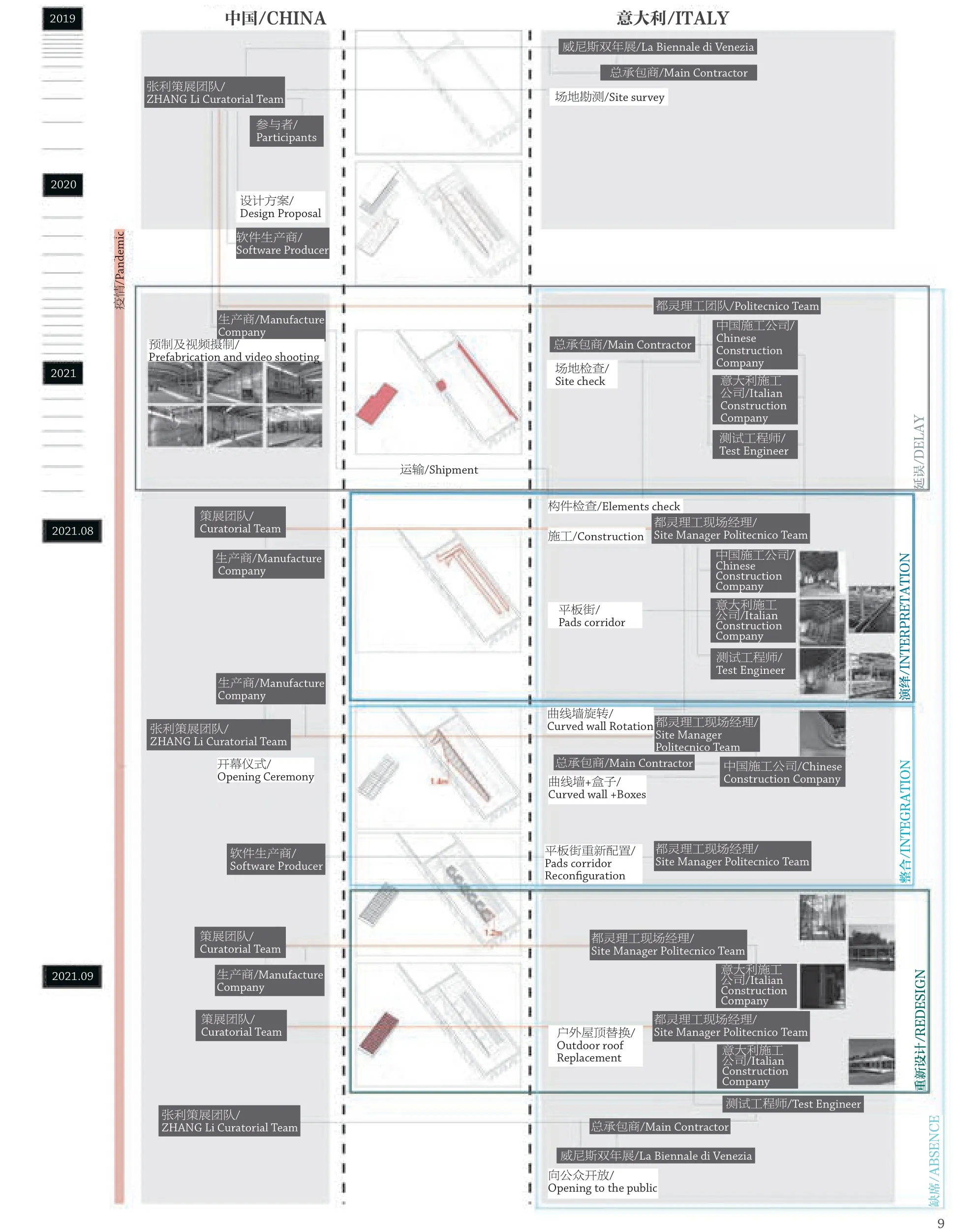
9 从设计概念到建筑。关于中国馆“关系”特征的图表:涉及的参与者、采取的行动、背景条件/From design concept to built up architecture. Diagram about the "relational" features of China Pavilion: actors involved, actions pursued, contextual conditions ©Marta Mancini, YU Ziyue, ZHANG Xian
What if the curator designer had been present on site? Would he have found different solutions to integrate the design?
Within the 17th edition of La Biennale di Veneice, the Chinese Pavilion was not the only one to face the "absence" of the curator architect on site. The Japanese Pavilion, for instance, was among the ones which encountered similar issues. Nonetheless, if in the Japanese case the curator "accepted" the condition of distance from the site - as well as the partial lost of the installation's components during the shipment, embracing it as conceptually part of the exhibition[8]- in the China Pavilion, the goal was to respect the original design as much as possible when facing unexpected situations. The selection of a trustworthy site manager was key to the achievement of the final outcome.
In ordinary architectural construction processes, if the designer was always present on site, documentation of the project would not be needed. The architect could illustrate step by step the operations to follow, what measurements to take, what volumes to build. He could instruct the craftsmen on how to shape and display the components. Yet, architects - due to a number of different reasons - are often absent and delegate the actuality of their tasks to documents[9]. In turn, documents need to be translated and interpreted. As argued by former OMA designer, Ole Scheeren: "The process of interpretation and translation is one, and design is one that only stops when the building is finished. And sometimes it's not even there, because the building keeps on changing."[10]
Drawings are one of the main means of the architect, tools of exploration and experimentation. They are done prior to construction, "they exist before tectonic experiences could take place"[11]. They are exploited for their unforeseen generative power of a reality outside the drawing. They unveil the building-to-come and at the same time allow to fix alternatives unfamiliar ideas[12]. However, "the transmutation that occurs between drawing and building remains to a large extent an enigma"[13].
Although the realisation process of the China Pavilion presented conditions of compelled delays and absences, the final built up exhibition embodied abilities of dialogue and cooperation among the curatorial team, the site manager team and the construction companies. Modifications and integrations were discussed during fruitful negotiations that brought to unplanned outcomes of high quality. Filled in with knowledge regarding the curator's vision and modus operandi due to many years of previous collaborations[14], in some cases, the supervising team solely supported the interpretation of the original design drawings, in few others, it acted as proactive designer.
The pandemic has been impacting on the way architecture is conceived and produced. The absence of the designer on site may often result in a significant reduction of process efficiency and aesthetic effectiveness or even in accidents[15]. Nonetheless, China Pavilion proved how architecture can still happen and how a relationship of mutual trust and intellectual exchange can turn absence into a dialogic process of uplanned yet high-quality architectural production.□
